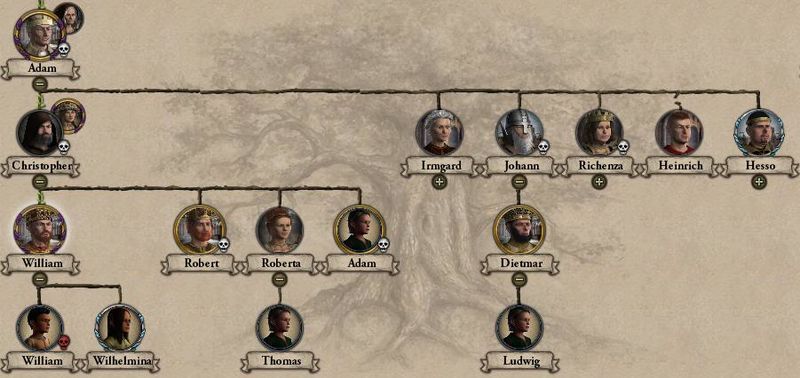Primogeniture is a succession law where the eldest son (or daughter, if gender laws permit) inherits all titles.
Features
- Right balance between ultimogeniture and seniority, with experienced heirs inheriting the realm, but not too old so they can still achieve things in their reigns.
- Title usually stays within ruler's branch of the dynasty, making it more important to educate heirs properly and ensuring that they stay out of trouble/danger before succession.
- Can be problematic in case of an old ruler outliving his eldest son; inheritance going directly to the deceased eldest son's under-age son, making a succession crisis likely.
- One of the few succession laws available to Indian religions.
- Unavailable for Muslim and tribal pagan rulers.
- Without Conclave DLC activated: Requires at least High crown authority, and is the succession law which requires the highest Crown Authority.
- With
 Conclave DLC activated: Requires Late Feudal Administration, regardless of de jure kingdom laws.
Conclave DLC activated: Requires Late Feudal Administration, regardless of de jure kingdom laws.
Opinion
A ruler under primogeniture succession will face the following opinion modifiers:
| Character | Opinion modifier | Reason |
|---|---|---|
| Oldest child | +20 | Direct benefactor of law |
| All other children set to inherit | -20 | They would prefer gavelkind |
| All other dynasty members | -5 | Title less likely to pass to other branches of dynasty. |
Mechanic
The heir to a ruler's title with primogeniture succession is determined through several steps, ranked from more to less important. Through this whole process, all people are assumed alive, even those who are dead.
- The eligible children of the ruler are divided into man/woman categories if gender laws apply. These categories are ranked according to these laws.
- The eligible children of the ruler are then ranked within these categories according to their age.
- The highest ranked child inherits the title. If this character happens to be dead, he is considered to have died just after his inheritance and steps 1-3 are repeated to determine his/her heir.
- If there are no eligible heirs to be found among a dead character's descendants, this character is disqualified from succession and we move up to his/her father as the heir. Again, if this person happens to be dead, he is considered to have died just recently and we start the process again until an eligible heir has been found.
- Under agnatic-cognatic succession: If a woman is found to be an heir but she has son(s), she will be ranked after her son(s). A woman with a son is ranked before a woman without a son, regardless of her age.
- Under absolute cognatic succession: The oldest child inherits regardless of gender.
Example
In the family tree included to the right, William is an emperor that follows agnatic-cognatic primogeniture succession.
According to rules 1 and 2, his son William is first to inherit and his daughter Wilhelmina second. Since William the Younger is dead and childless, he is disqualified according to rules 3 and 4. So, Wilhelmina is the first heir.
Because emperor William has no more descendants, we move up to his father Christopher. He is dead, so we move to Robert, the second eldest son. He is dead and childless, so he is disqualified. We then move to Adam but are faced with the same problem. Since there are no more sons, Roberta is next in line as the eldest daughter. However, according to rule 5, her son Thomas takes precedence. So Thomas is the second heir and Roberta the third.
All of Christopher's descendants have been assessed, so we can move up again in the family tree to Adam. Johann is next in line to succeed. He may be dead, but that does not mean his children are ranked any lower. His son Dietmar is the fourth heir we find. From the same principle, Dietmar's son Ludwig is the fifth heir.
The order of succession is:
- Wilhelmina
- Thomas
- Roberta
- Dietmar
- Ludwig
Strategies
If a kingdom is already in existence, attempting to switch to primogeniture may be a daunting task due to the high CA requirement. However, with the ![]() Conclave DLC activated, the requirement of Late Feudal Administration is easier to obtain.
Conclave DLC activated, the requirement of Late Feudal Administration is easier to obtain.
- Secure favors from your councilors: Sway enough of them to vote for the administration change.
- Switch to Primogeniture indirectly: If you have Gavelkind or Elective gavelkind succession laws and wish to escape into Primogeniture, consider changing to Seniority or Elective first, while working up your Crown Authority (or Late Feudal Administration with Conclave).
- Independent dukes and counts whose de jure kingdoms do not exist can consider changing to primogeniture before creating kingdoms.
- If possible, switch to a different religion from your de jure king: Crown law applications are different if you and your de jure king have different religions. Beware of switching to a heretical or infidel religion, as that presents different problems.
